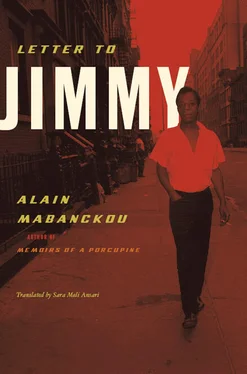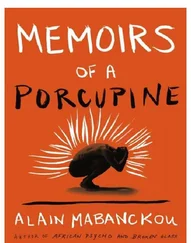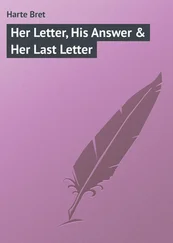If I imagined Baldwin coughing slightly from time to time when I was writing Letter to Jimmy , or imagined his footsteps near my library, I would lift my eyes and see before me the photo taped to the wall, in front of my desk. This photo is essentially the source of our encounter. I had bought it in the late 80s from a bouquinistes , a used bookseller’s kiosk, along the Seine. Baldwin had looked at me then as if he were begging me to save him from his public display. The bookseller shared with me the information that he had known the author, whom he had seen walking around “over there”—he pointed to the Place Saint-Michel. Should I have believed him? I bought the photo and walked down into a Metro station. .
Sitting in the Metro, I studied Baldwin’s features closely. I was half dozing. My own life appeared to me now in black and white, like the image. I had the feeling that I had known this man, that I had met him in the old quarters of Pointe-Noire, in Congo. He had the face of the brother I would have liked to have had, and of the biological father I had never known — Baldwin had not known his father either, a fact that played an undeniably major role in his work. In essence I was asking Baldwin to adopt me, to take my hand, to lead me to “another country” where “no one knows my name.” And so I invented for myself a brother in his image, and a father in his image. Alas, I would discover that he would make David, his main character in Giovanni’s Room , say: “People can’t, unhappily, invent their mooring posts, their lovers and their friends, anymore than they can invent their parents. Life gives these and also takes them away and the great difficulty is to say Yes to life.” These words echo through my thoughts still today. The destruction they inflicted on my imaginary world was similar to that endured by a kid to whom it has been suddenly revealed that Santa Claus does not exist. To console myself at the time, I tucked Baldwin’s image between the pages of books I was reading, whether they were written by him or by others. In this way we were reading the same books and we were traveling together. Much later — I had already moved to the United States — I came upon the same image in a bookstore in a new edition of one of Baldwin’s novels. I no longer felt the same as I once had in France, since my image of him now hid a story behind it, a chance encounter that could not be reproduced. .
Every time I look again at “my” photo, my eyes linger on the wrinkles of Baldwin’s face. They are furrows, footpaths I have to follow in order to make my way to the clearing where I might hear his voice, where he might share with me at last the secrets he did not reveal during his lifetime. His smile is faint, and changes as often as I try to describe it. But his eyes, most of all! “Those big eyes — prominent on your face, that once mocked your father, unaware that they would later peer into souls, or that they would pierce through the darkest part of humanity, before closing forever — still hold their power to search deeply, even from the next life,” I would write, at the beginning of my Letter to Jimmy . .
I situate Baldwin’s novel Giovanni’s Room at the peak of his creative production, and The Fire Next Time at the height of his thought as a champion of civil rights. With it, Baldwin changed my previous understanding of the world. After reading The Fire Next Time , you can no longer look at society in the same way. What, after all, does Baldwin teach us if not that desperation, internal agony and “the unbearable lightness of being” haunt all races? From there, the writer must invent — or even reinvent — a universe in which neighborly love is our only salvation, since none of us can hide from the inevitable truth: “Life is tragic simply because the earth turns and the sun inexorably rises and sets, and one day, for each of us, the sun will go down for the last, last time.” Baldwin based his dream on the redemption of human nature, on reclaiming what we lost a long time ago: the beauty of life. When all is said and done, what can inspire us more than these words? “Perhaps the whole root of our trouble, the human trouble, is that we will sacrifice all the beauty of our lives, will imprison ourselves in totems, taboos, crosses, blood sacrifices, steeples, mosques, races, armies, flags, nations, in order to deny the fact of death, the only fact we have.”
Alain Mabanckou
1. James Baldwin, “The Fire Next Time” in Collected Essays of James Baldwin , ed. Toni Morrison (New York: Library of America, 1998), 334-5.
2. Ibid., 334-5.
3. Ibid., 334-5.
4. James Baldwin, “Notes of a Native Son” in Collected Essays of James Baldwin , ed. Toni Morrison (New York: Library of America, 1998), 42.
5. Ibid., 42.
6. James Baldwin, Conversations with James Baldwin , eds. Fred Standley and Louis H. Pratt (Jackson: University Press of Mississippi, 1989), 77–78.
7. Ibid., 199.
8. David Leeming, James Baldwin: A Biography (New York: Knopf, Distributed by Random House, 1994), 3.
9. Benoît Depardieu, James Baldwin (Paris: Belin, 2004), 20–21.
10.“Notes of a Native Son,” op. cit., 13.
11. Ibid., p. 68.
14. Ibid., 161.
15. James Campbell, Talking at the Gates: A Life of James Baldwin (New York: Penguin Books, 1991), 10.
16. Ibid., p. 40.
17. Ibid., p. 37.
18. Ibid., p. 38.
19.“Notes of a Native Son,” op. cit., 9.
20.“The Fire Next Time,” op. cit., 307.
21. Ibid., 309.
22. Ibid., 307.
23.“Notes of a Native Son,” op. cit., 75.
24. Ibid, 64.
25.“The Fire Next Time,” op. cit., 291.
26.“Notes of a Native Son,” op. cit., 66.
27. Depardieu, op. cit., p. 17.
28. Leeming, op. cit., 17.
29.“The Fire Next Time,” op. cit., 327.
30. Ibid., p. 14.
31.“Notes of a Native Son,” op. cit., 6.
32. Michel Fabre, La Rive noire: les écrivains noirs américains à Paris, 1830–1995 (Marseille: André Dimanche, 1999), 71.
33.“Notes of a Native Son,” op. cit., 9.
34. Robert Coles, “James Baldwin Back Home,” New York Times , July 31, 1977.
35. Ibid.
36. James Campbell, Exiled in Paris: Richard Wright, James Baldwin, Samuel Beckett and Others on the Left Bank (Berkeley: University of California Press, 2003), 24.
37. Hazel Rowley, Richard Wright: The Life and Times (New York: Henry Holt, 2003).
38. James Baldwin, “Nobody Knows My Name” in Collected Essays of James Baldwin , ed. Toni Morrison (New York: Library of America, 1998), 259.
39. Leeming, op. cit., 49.
40.“Notes of a Native Son,” op. cit., 5.
41. Leeming, op. cit., 52–53.
42. Campbell, Exiled in Paris , op. cit., 24.
43. Benoît Depardieu, op. cit., 28–29 (quotation drawn from “Nobody Knows My Name” and translated into French by Benoît Depardieu in his book. The exact source of Depardieu’s original English citation of Baldwin’s work is unclear).
44.“Notes of a Native Son,” op. cit., 11–18.
45. Ibid., p. 20.
46. Amanda Claybaugh, Introduction and Notes to Uncle Tom’s Cabin, by Harriet Beecher Stowe (New York: Barnes & Noble Classics, 2003), xxxvi.
47. Notes of a Native Son , op. cit., 12.
48. Depardieu, op. cit., 80.
49. Claybaugh, op. cit., xiv — xv.
50. Ibid., xviii.
51. Notes of a Native Son , op. cit., 16.
52. Ibid., p. 23–24.
53. Claybaugh, op. cit., xxxii.
54.“Notes of a Native Son,” op. cit., 19–35.
55. Ibid., 30.
56. Ibid., 27.
Читать дальше












